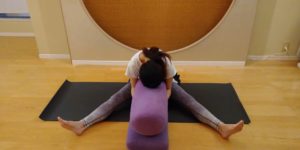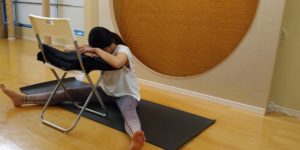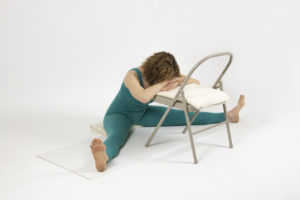
Photography by @Kanoko Fukui and modeling by @Nao Onishi
by Leza
Supported Wide Angle Forward Bend (Salamba Upavista Konasana) is a calming pose that is also a good release for the back body. It gently stretches the lower back and the backs of the legs, and releases tension in the shoulders and neck. It also stretches the inner thighs and groins, areas that gets tight and protected in both men and women.
It’s a quieting pose, as forward folds in general are inward focused. So Supported Wide Angle Forward Bend is an excellent pose for reducing stress, calming the nervous system, and quieting the mind.
I recommend practicing this pose often during busy seasons and whenever you need some time to go within, release tension, and re-set.
Caution: Those with groin or hamstring injuries, or with severe neck issues should avoid this pose.
Time: 2-4 minutes, or more if desired. If resting on one cheek, make sure to stay in the pose for an equal amount of time on each cheek.
Setting Up
To set up for the pose, you’ll need the following: yoga mat, 1 bolster, 2-3 blankets as needed. For some variations, you’ll also need a chair and/or two sandbags.
Start by spreading a yoga mat on the floor. Place a yoga bolster or stack of blankets by the side of the mat. If you’re planning on using a chair instead of folded blankets, place the chair on the mat and place a folded blanket on the seat of the chair.
If your hamstrings or hips are tight, fold a blanket to sit on.
To Come Into the Pose
Sit in a crossed legs position in the center of the mat, either on the mat itself or on the edge of a folded blanket. From there, sit up tall, as find your sitting bones and letting them settle into the ground.
Take your legs out in front of you and open them up as wide as is comfortable. Place the bolster, stack of blankets, or chair between your legs. The bolster can be placed vertically or horizontally on the mat.
As you inhale, lengthen your spine. As you exhale, fold yourself forward from your hip joints over the props. Make sure your neck is long and your shoulders are soft.

Either rest your forehead on the bolster or turn your head to the side and rest on one cheek, whichever is more comfortable. If you are resting on one cheek, make sure to switch to the other side halfway through your time in the pose.
Practicing the Pose
Elongate the back of your neck, allowing your forehead or cheek to relax onto the props. Invite your shoulders to release.
Take several slow, deep breaths, melting into the support. Sense all the places you feel your body making contact with the props and the ground, and allow yourself to settle. Turn your attention inward and focus on your breath. Greet the sensations in your back body, groins, inner thighs, and entire body with an open mind, observing without judgment. If emotions arise, observe them and the changing sensations in loving awareness. If you feel any pain or discomfort, gently come out of the pose.
You can also try releasing tension, stress, anxiety, worry, and exhaustion on the exhalation and cultivating peace, self-love, and comfort on the inhalation.
In quieter holds, anchor your awareness in the sensations in your body by following the breath as it moves in and out, finding stillness as you open and expand into the pose.
Variations
Less flexible people or people who just want a very supported version of this pose can do the pose with a chair instead of a bolster. Place your folded arms on the chair seat and rest your forehead on your stacked hands.


If your knees require additional support due to tight hamstrings, slide a rolled-up blanket under each of them.
For a deeper sense of grounding, place a light sandbag on each of your thighs.
This pose can also be done as a forward bend to one side at a time, as in this photograph. This variation stretches the sides of the body, the waist, and the lower, middle, and upper back. Releasing muscle tension in those areas may enhance your relaxation. Make sure to time the pose the same amount of time on each side.

You can read more about Leza’s writing at www.lezalowitz.com and about her yoga studio and classes at www.sunandmoon.jp.
• Follow Yoga for Healthy Aging on Facebook and follow Nina on Instagram • Order Yoga for Times of Change here and purchase the companion videos here • Order Yoga for Healthy Aging: A Guide to Lifelong Well-Being here.


Leave A Comment